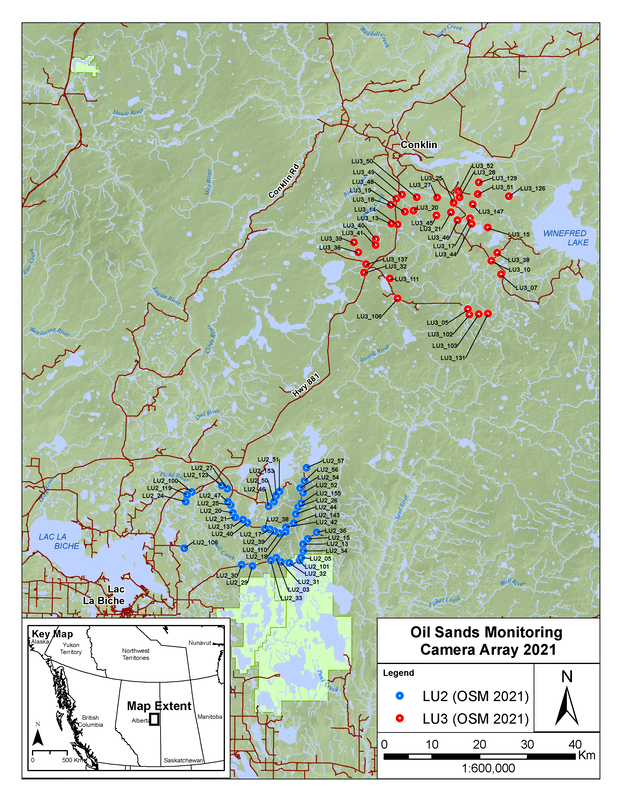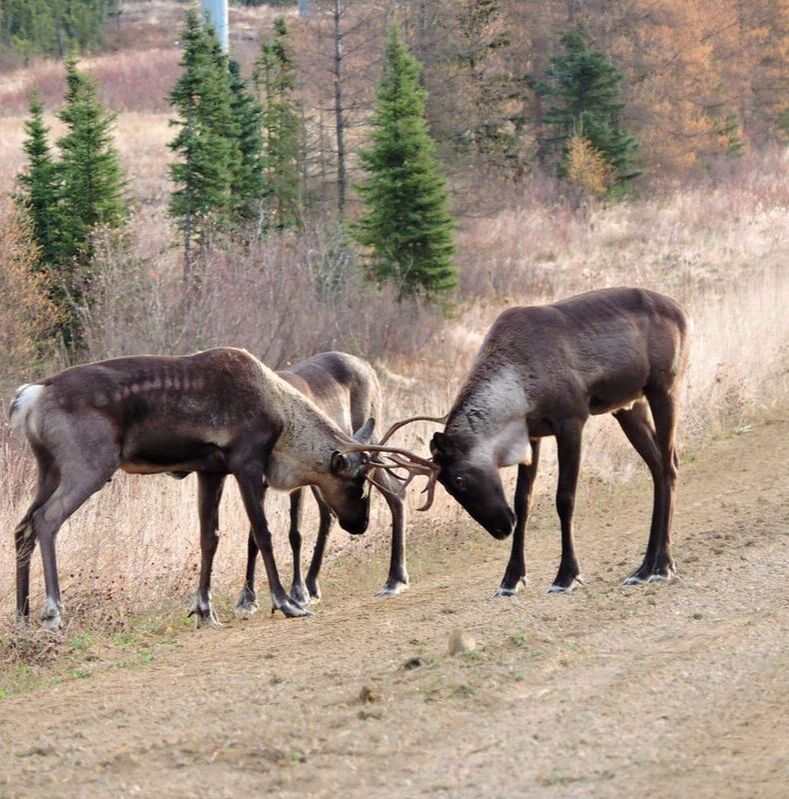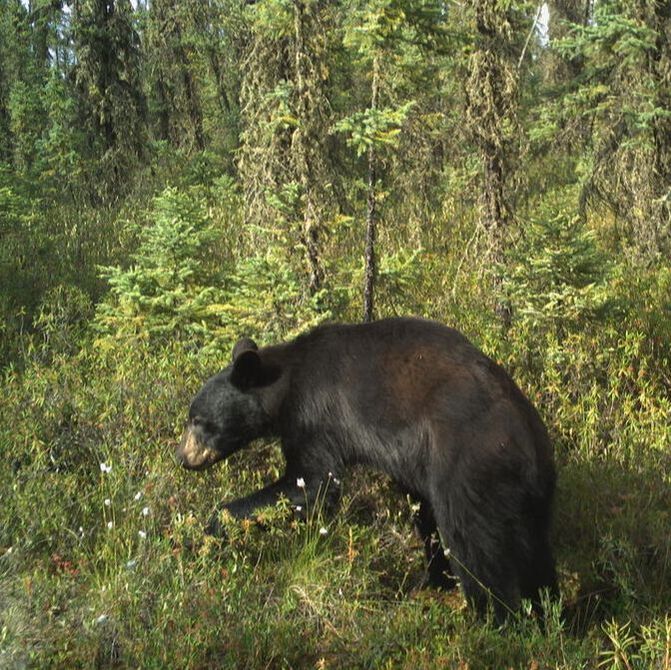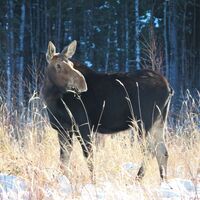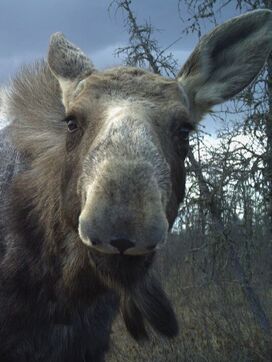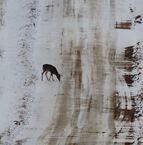Boreal Landscapes - Oil sands monitoring (2021)
Data Portal
|
Data type: Camera data
Landscapes: 2 Camera sites: 100 Area: 3500 km2 |
|
|
The Oil Sands Monitoring (OSM) program is a joint federal-provincial program, funded by industry, to explore the effects of oil sands development on water, air, and land. It is the largest research and monitoring effort in the western boreal forest.
The Terrestrial Biological Monitoring (TBM) program examines amphibians, birds, and mammals. TBM is made up of researchers from several Universities, institutes, and consultancies. The TBM is guided by an independent Technical Advisory Committee (TAC) made up of specialists from First Nations, ENGOs, industry, and government. Under the TBM, we have been co-leading the Mammals Component, using camera-trap arrays spread across multiple landscapes. It is one of the biggest camera-trapping efforts in Canada. |
|
In 2020 we launched our new mammal monitoring program based on the BADR design: Before-After Dose-Response. This nested design monitors biodiversity within and among Landscape Units, or LUs. Explore more on this innovative design here.
In 2021-2022 we put BADR on the ground on two landscape units: a high-disturbance landscape and a low-disturbance landscape. In 2022 we went for full implementation and deployed another 4 landscapes; in 2023 we will deploy another 4 landscapes. Want to do your own science on the effects of oil sands on mammals? You can access all of the data on mammal communities in our DATA PORTAL above. |
|
Publications
Fuller*, H.W., S. Frey*, and J.T. Fisher. 2022. Integration of aerial surveys and resource selection analysis indicates human land-use supports boreal deer expansion. Ecological Applications, Early view. Fisher, J.T., and A. Ladle. 2022. Syntopic species interact with large boreal mammals' response to anthropogenic landscape change. Science of the Total Environment 822: 153432. Tejero, D.*; S. Frey*, K. Baillie-David*, A.C. Burton, and J.T. Fisher. 2022. Predator control alters wolf interactions with prey and competitor species over the diel cycle. Oikos, e08821. Fisher, J.T., and A. Ladle*. 2022. Syntopic species interact with large boreal mammals' response to anthropogenic landscape change. Science of the Total Environment 822: 153432 Roberts, D., D. Beausoleil, R. Hazewinkel, A. Mahaffey, D. Sayanda, F. Wyatt, E. Bayne, J. Dennett, J.T. Fisher, and M. Dubé. 2021. A decadal synthesis of terrestrial biological monitoring in the Alberta oil sands region. Integrated Environmental Assessment and Management 18(2): 388-406. Darlington*, S., A.C. Burton, A. Ladle*, J.P. Volpe, and J.T. Fisher. 2022. Cumulative effects of human footprint best predict seasonal resource selection by a range expanding ungulate. Scientific Reports 12(1072). Roberts, D., D. Beausoleil, R. Hazewinkel, A. Mahaffey, D. Sayanda, F. Wyatt, E. Bayne, J. Dennett, J.T. Fisher, and M. Dubé. 2021. A decadal synthesis of terrestrial biological monitoring in the Alberta oil sands region. Integrated Environmental Assessment and Management, early view. Media coverage: CBC News Wittische, J., S. Heckbert, P.M.A. James, A.C. Burton, and J.T. Fisher. 2021. Community-level modelling of boreal forest mammals in an oil sands landscape reveals how human disturbance, natural habitat, and predation shape mammal distribution. Science of the Total Environment 75(2): 142500. Fisher, J.T., and A.C. Burton. 2021. Spatial structure of reproductive success infers mechanisms of ungulate invasion in Nearctic boreal landscapes. Ecology & Evolution 11(2): 900-911. Fisher, J.T., A.C. Burton, L. Nolan, and L. Roy. 2020. Influences of landscape change and winter severity on invasive ungulate persistence in the Nearctic boreal forest. Scientific Reports 10: 8742. Frey, S*., J.P. Volpe, N. Heim*, J. Paczkowski, and J.T. Fisher. 2020. Move to nocturnality not a universal trend in carnivore species on disturbed landscapes. Oikos 129: 1128-1140. Media coverage: Rocky Mountain Outlook, CBC Radio, CTV News, CTV News online, Outside Magazine Fisher, J.T., and A.C. Burton. 2018. Wildlife winners and losers in an oil sands landscape. Frontiers in Ecology and Environment, 16(6): 323-328. Media coverage: National Post, CBC, CBC Radio, The Star, Global News, Affiliates coast to coast; Canadian Wildlife Magazine Burgar, J.M.*, J.P. Volpe, J.T. Fisher, and A.C. Burton. 2018. The importance of considering multiple interacting species for conservation of species at risk. Conservation Biology, 33(3): 709-715.27. |

